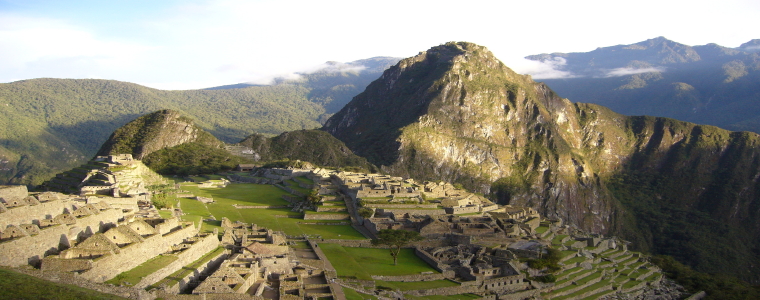|
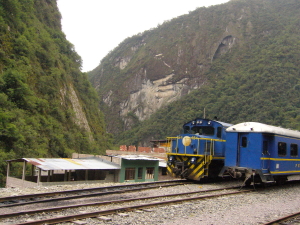 After
our morning visit to the Ollantaytambo Ruins, we boarded the train
for Machu Picchu. From Ollantaytambo, it is a 1-1/2 hour ride to
the town of Aguas Calientes which is the nearest town to the ruins.
The train has a vista dome and the views along the way are quite
interesting. We could see hikers along the Inca Trail - a one to
four day trek over the mountain depending on where you start. After
our morning visit to the Ollantaytambo Ruins, we boarded the train
for Machu Picchu. From Ollantaytambo, it is a 1-1/2 hour ride to
the town of Aguas Calientes which is the nearest town to the ruins.
The train has a vista dome and the views along the way are quite
interesting. We could see hikers along the Inca Trail - a one to
four day trek over the mountain depending on where you start. 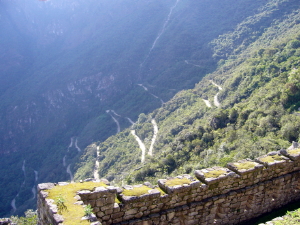 Once
in Aguas Calientes, it is a 30 minute bus ride up a steep, 13 hairpin
mountain road to the actual ruins. We were fortunate to have reservations
at the only hotel at the ruins, the Sanctuary Lodge. This meant
we would be the first visitors to the ruins in the morning and could
watch (and photograph) the sunrise over Machu Picchu. Once
in Aguas Calientes, it is a 30 minute bus ride up a steep, 13 hairpin
mountain road to the actual ruins. We were fortunate to have reservations
at the only hotel at the ruins, the Sanctuary Lodge. This meant
we would be the first visitors to the ruins in the morning and could
watch (and photograph) the sunrise over Machu Picchu.
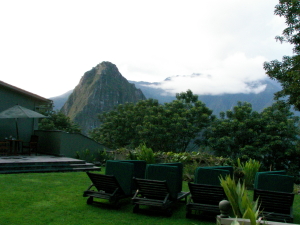 When
we opened the sliding doors of our room out to the patio, we were
surprised to see the imposing site of Huayna Picchu rising out of
the clouds. The lodge also has lovely pathway that winds thru a
beautiful garden with several water falls. When
we opened the sliding doors of our room out to the patio, we were
surprised to see the imposing site of Huayna Picchu rising out of
the clouds. The lodge also has lovely pathway that winds thru a
beautiful garden with several water falls.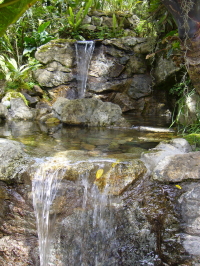
After a buffet lunch at the hotel, we had our first visit to the
"Lost City". Machu Picchu was discovered almost by accident
by an American explorer and professor of History, Hiram Bingham,
in 1911. The impressive stone ruins of the sun-worshiping Inca,
the last of Peru's great pre-Columbian civilizations, were hidden
for more than 300 years beneath semi-tropical vegetation. Many of
the tombs found during this and successive expeditions showed traces
of earlier looting by treasure hunters. No golden objects were found
but many made of copper and diverse ceramic objects were uncovered.
173 humans were found - 150 female and 23 male. The Inca had no
written language and there are no historical sources that mention
the existence of this place so the names and functions assigned
its buildings are Binghams's interpretation. Many theories have
been put foward as to its possible role as a strategic fortress,
as a refuge of the last Incas fleeing Spanish conquest, or a place
of worship linked to the observations of the stars.
Besides the high quality of its architectural development and Inca
masonry art, Machu Picchu owes a great part of its beauty to the
surrounding landscape and majestic location of the city. It is surrounded
by the glacier covered Andes Mountains, between the mountain summits
of Huayna Picchu and Machu Picchu. The Inca city of Machu Picchu
is comprised of temples, palaces, shrines, plazas, streets, baths
and some 200 dwellings which must have housed an exclusive cast
of noblemen and the privileged. It also contains a wide zone of
terraces with irrigation channels that were used for planting potatoes
and maise to feed an estimated 1,000 residents. Construction was
an engineering feat, with work done by people who had no steel tools,
no wheeled carts and no beasts of burden besides the llama. The
major structures are finely crafted of large stone blocks fitted
at perfectly chiseled angles. The following are some of the most
famous sites in Machu Picchu. To view additional pictures of the
ruins, go to Machu Picchu Photo
Gallery.
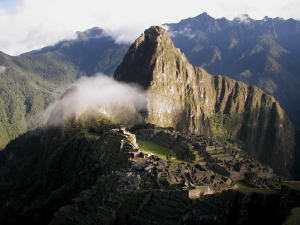 |
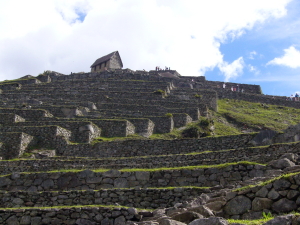 |
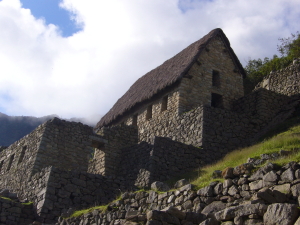 |
|
Sunrise over Machu Picchu
|
Looking up at Caretakers Hut
|
Guardhouse
|
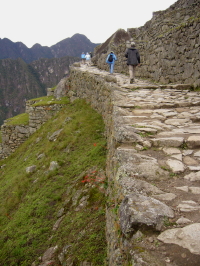 |
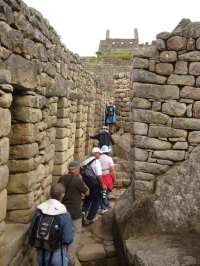 |
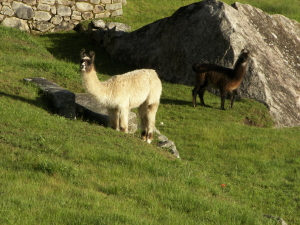 |
|
Path along Terrace
|
Hiking to the top of the Ruins
|
Llamas Grazing on Terraces
|
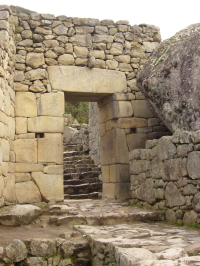 |
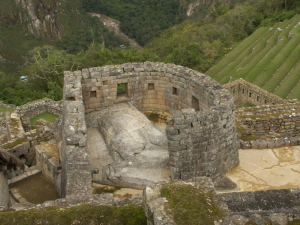 |
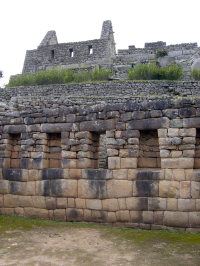 |
|
City Entrance Gate - Note 2 holes on side
and stone ring on top used to hold bars locking the gate.
|
Temple of the Sun - On the winter solstice
(6/21) the sun shines directly through the eastern window;
on the summer solstice (12/21) the sun shines through the
southeast window.
|
Northern District Ruins
|
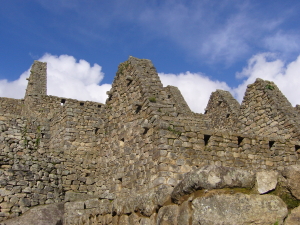 |
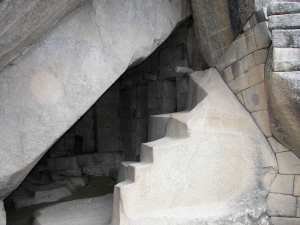 |
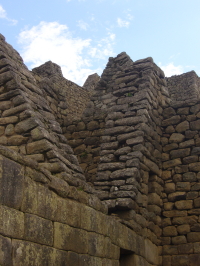 |
|
Royal Palace
|
Royal Tomb
|
Example of Stone Construction
|
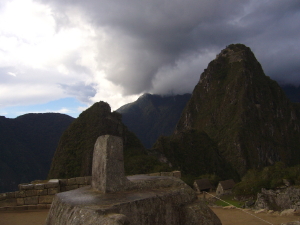 |
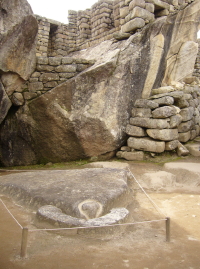 |
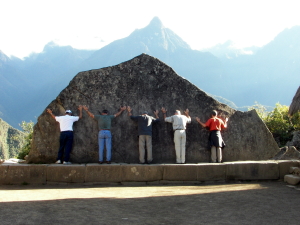 |
|
Intihuatana - Hitching Post of the Sun.
This carved stone altar whose shadows marked the changing
seasons, enabled Inca priests to predict such events as the
winter solstice which marked the beginning of harvest and
sowing.
|
Condor Temple - Building is shaped like
body of condor. Large boulder is wings. Fenced stone is head.
|
Sacred Rock - Note similarity in form of
the rock and the mountain behind. Stretching arms out on rock
is said to concentrate great energetic power.
|
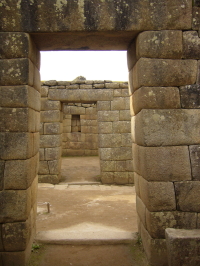 |
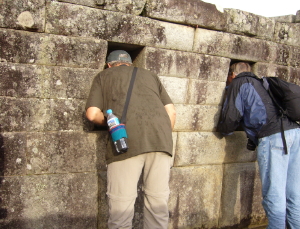 |
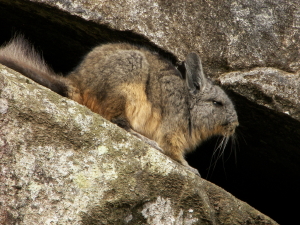 |
|
Doorways
|
Echo Chamber - Sound made inside is easily
heard by those in room
|
Rabbit-like animal (forgot it's name!)
|
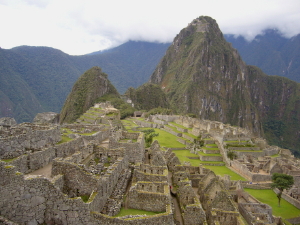 |
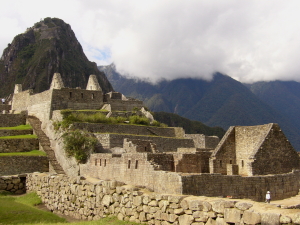 |
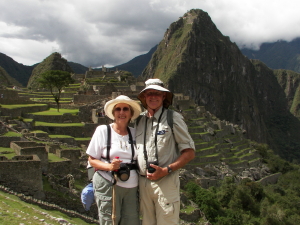 |
|
Overview of Machu Picchu - Huayna Picchu
is mountain rising in background and was used by the Inca
as a lookout.
|
Northern District Ruins
|
Carsons on Machu Picchu
|
Home Location
Descriptions Photos Map
Contact Us
|
